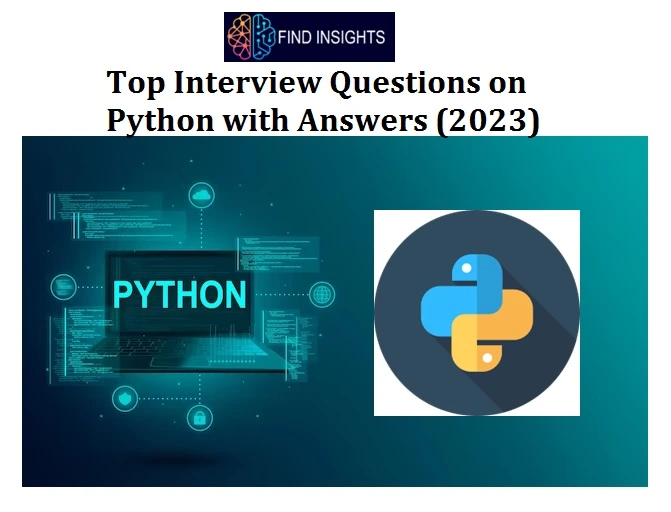
Introduction: Top Interview questions on python
Python has gained immense popularity in recent years due to its simplicity, versatility, and wide range of applications. Whether you are a seasoned developer or just starting your programming journey, it is crucial to be well-prepared for Python interviews. In this article, we will discuss the top interview questions on Python, covering various aspects of the language and its usage. So, let’s dive in!
Introduction to Python
Python is a high-level, interpreted programming language known for its simplicity and readability. It was created by Guido van Rossum and first released in 1991. Python supports multiple programming paradigms, including procedural, object-oriented, and functional programming. It has a vast standard library and a thriving community that contributes to a wide range of third-party libraries and frameworks.
Top Interview questions on python with Answers (2023)

Basic Interview Questions on Python
What is Python?
Python is an interpreted, high-level programming language known for its simplicity and readability. It emphasizes code readability with its clean and straightforward syntax, making it easier to write and understand.
What are the key features of Python?
Python offers several key features, including:
- Easy-to-learn syntax
- Readability and simplicity
- Interpreted nature
- Cross-platform compatibility
- Extensive standard library
- Support for multiple programming paradigms
- Integration capabilities with other languages
How is Python different from other programming languages?
Python differs from other programming languages in the following ways:
- Readability: Python code is easy to read and understand due to its clean and straightforward syntax.
- Simplicity: Python emphasizes simplicity, making it easier to write and maintain code.
- Versatility: Python supports multiple programming paradigms, allowing developers to choose the approach that best suits their needs.
- Extensive library support: Python has a vast standard library and a large ecosystem of third-party libraries and frameworks, providing solutions for various domains.
Data Types and Variables Interview Questions on Python

What are the different data types in Python?
Python provides several built-in data types, including:
- Numeric types: int, float, complex
- Sequence types: list, tuple, range
- Text type: str
- Mapping type: dict
- Set types: set, frozenset
- Boolean type: bool
How do you define a variable in Python?
In Python, you can define a variable by assigning a value to it using the assignment operator (=). The data type of the variable is dynamically inferred based on the assigned value.
What is the difference between local and global variables?
Local variables are defined within a specific scope, such as inside a function, and their scope is limited to that specific block. Global variables, on the other hand, are defined outside any function and can be accessed from anywhere within the program.
Control Flow and Looping
How do you write an if statement in Python?
In Python, you can use the if statement to perform conditional execution of code.
What is a for loop in Python?
A for loop is used to iterate over a sequence or collection of items. The loop variable takes on each item in the sequence one by one, and the associated block of code is executed for each iteration.
How does a while loop work in Python?
A while loop is used to repeatedly execute a block of code as long as a given condition is true. The loop continues until the condition becomes false.
What is a function in Python?
A function in Python is a named block of reusable code that performs a specific task. It takes input parameters (if any) and returns a value (if specified).
How do you define a function in Python?
You can define a function in Python using the def keyword, followed by the function name, parentheses for parameters (if any), and a colon.
What are modules in Python?
Modules in Python are files containing Python code that define functions, classes, and variables. They allow you to organize your code logically and also reuse it in different programs. You can import modules into your Python scripts using the import statement.
Object-Oriented Programming (OOP)
What is OOP?
Object-Oriented Programming (OOP) is a programming paradigm that organizes code around objects and data rather than actions and logic. It focuses on creating reusable and modular code by defining classes, which are used to create objects.
What are classes and objects?
A class is a blueprint or template for creating objects. It defines the properties (attributes) and behaviors (methods) that objects of that class will have. An object, on the other hand, is an instance of a class.
How do you achieve inheritance in Python?
Inheritance allows you to define a new class based on an existing class, inheriting its attributes and methods. In Python, you can achieve inheritance by creating a new class and also specifying the base class in parentheses after the class name.
File Handling
How do you read from a file in Python?
In Python, you can read from a file using the open() function and the read() method.
How do you write to a file in Python?
To write to a file in Python, you can use the open() function with the file mode set to "w" (write mode) or "a" (append mode), and then use the write() method to write content to the file.
What are the different file modes in Python?
"r": Read mode (default). Opens the file for reading."w": Write mode. Opens the file for writing. Creates a new file if it doesn’t exist or truncates the file if it exists."a": Append mode. Opens the file for writing. Appends content to the end of the file if it exists; creates a new file otherwise."x": Exclusive creation mode. Creates a new file, but raises an error if the file already exists.
Exception Handling
What is an exception in Python?
An exception is an event that occurs during the execution of a program, disrupting the normal flow of instructions. When an exception occurs, Python raises an exception object, which can be caught and handled using exception handling.
How do you handle exceptions in Python?
In Python, you can handle exceptions using the try-except block. The code that may raise an exception is placed inside the try block, and also the code to handle the exception is placed inside the except block.
What is the purpose of the finally block?
The finally block is used to specify code that will be executed regardless of whether an exception occurred or not. It is placed after the try-except block.
Libraries and Frameworks
What are some popular libraries in Python?
Python has a rich ecosystem of libraries for various purposes. Some popular libraries include:
- NumPy: Numerical computing library.
- pandas: Data manipulation and analysis library.
- Matplotlib: Data visualization library.
- scikit-learn: Machine learning library.
- TensorFlow: Deep learning library.
- Django: Web framework.
- Flask: Lightweight web framework.
- Requests: HTTP library for making requests.
How do you install a library in Python using pip?
You can install a library in Python using the pip package manager, which is a default package manager for Python.
What is Flask?
Flask is a popular lightweight web framework for Python. It provides tools, libraries, and also technologies to build web applications easily. Flask follows the WSGI (Web Server Gateway Interface) standard and is known for its simplicity and also extensibility.
Best Practices in Python
What are some best practices for writing clean and efficient Python code?
- Follow PEP 8 guidelines for code style and formatting.
- Use meaningful variable and function names.
- Write modular and reusable code.
- Avoid unnecessary complexity.
- Write docstrings and also comments to improve code readability.
- Test your code thoroughly.
How do you handle dependencies in Python projects?
Python projects often rely on external libraries and dependencies. You can manage dependencies using tools like pip and also virtual environments. It is recommended to use a requirements.txt file to list all the project dependencies, making it easier for others to install and also reproduce the project environment.
What is PEP 8?
PEP 8 is the official style guide for Python code. It provides guidelines and best practices for writing clean and readable Python code. Following PEP 8 helps maintain consistency across Python projects and makes the code more accessible to others.
Conclusion
In this article, we covered the top interview questions on Python, ranging from basic concepts to more advanced topics like OOP, file handling, and also best practices. By understanding and preparing for these questions, you can confidently showcase your Python skills during interviews. Remember to practice writing code and explore real-world scenarios to deepen your understanding of Python.
LIKE WHAT YOU’RE READING?
CHECK OUT SOME OF OUR OTHER GREAT CONTENT HERE
- PYTHON LAMBDA FUNCTION: A COMPREHENSIVE GUIDE
- ARTIFICIAL INTELLIGENCE (AI) – A BEGINNER’S GUIDE
- HOW TO START A CAREER IN ARTIFICIAL INTELLIGENCE?
- WHAT IS MACHINE LEARNING?
- DATA SCIENCE – THE ULTIMATE GUIDE
- TOP 5 BEST SEO TOOLS(2022)
- TOOLS OF MACHINE LEARNING
- 7 MOST POPULAR TOOLS FOR DEEP LEARNING




1 Comment